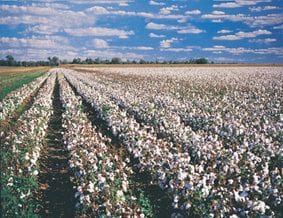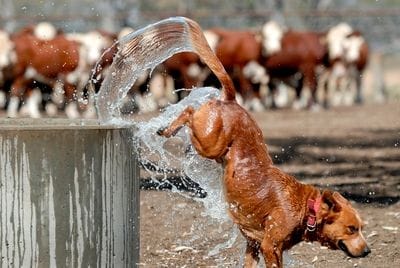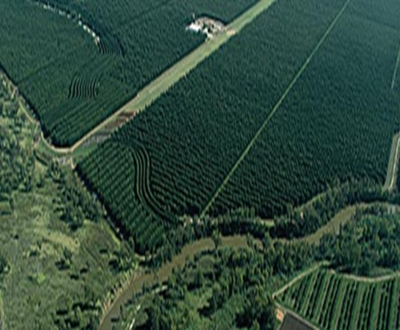Agriculture
From the 1840s, when the first white settlers arrived on our plains, agriculture has been the backbone of the district. Blessed with some the world's richest black soil, the area soon became known as the Golden Wheatbelt for the huge crops of top quality seed produced here. As more pioneers arrived to try their luck in this wide brown landscape, communities grew and the need for reliable food supplies saw sheep and cattle farming take hold alongside grain production. Agriculture has diversified enormously since the early days, due in part to the droughts which sometimes affect Australia, and now encompasses a wide variety of crops and other agricultural developments.
 WHEAT & BROADACRE FARMING
WHEAT & BROADACRE FARMINGWheat has been part of the human diet for thousands of years with crops first being cultivated in 9600BC. Along with rice and maize/corn, wheat is one of the most heavily produced crops worldwide. Whilst we've only been growing wheat for a couple of centuries we certainly know how to grow the very best wheat with Moree Plains Shire contributing an average of one million tonnes of the golden grain with an estimated value of $180 million for the local economy.
Considered a winter crop, wheat is planted from late autumn through to early winter with lower soil temperatures suiting the germination and growth of a bumper crop. Harvest commences in November and varies in length depending, as always, on the weather. It is imperative to harvest the ripe grain as quickly as possible when the weather is fine as rain will cause a drop in the quality of the seed by lowering the protein levels.
Once harvested on the farm, the grain is transported by truck to nearby grain terminals where the quality of the wheat is determined. From here, the wheat can be exported overseas through the seaports or distributed to Australian mills for national consumption. That loaf of bread on your table takes approximately 9 months from planting to consumption with long hours of hard toil involved for farmers and their families who often work around the clock for days on end at harvest time.
Over time, the types of broadacre crops have evolved and increased to accommodate changing market tastes and to provide an alternative income for farmers given the demanding and quixotic nature of Australia's weather. The term "broadacre" simply describes a large area of land dedicated to the growth of one type of crop. Other broadacre crops include oil seeds such as canola, safflower and sunflower, cereal crops such as barley, oats and sorghum plus legume or pulse crops such as fava beans, mung beans and chickpeas. At different times of the year, the wide plains of the Moree district are a natural tapestry as the beautiful differing colours of the bounteous crops flood the land.
COTTON

Would you like to know what goes into producing a successful cotton crop? We can show you exactly what it takes to grow a pair of jeans! Since the mid-1970s, the Moree district has made a significant contribution to Australia's cotton production with top quality yields for use nationally and internationally.
Planting occurs in October dependant on the soil temperature which must be 15°C or above for successful germination and prevention of sub-soil disease. Cotton can be grown as a dryland crop which relies solely on natural rainfall or can be irrigated using regular, stored water-flows to ensure a robust, heavy-bearing crop. The development of pest resistant plant strains has resulted in a significantly reduced use of chemicals throughout the plant's life cycle. The industry continually strives to lift production standards while being conscious of sustainability, caring for our natural resources and treading gently on the earth.
Harvest can commence as early as March in the next calendar year and go through to the end of July depending on the climatic conditions. The composition of cotton is approximately 40% fibre, 50% seed and 10% trash (leaf & stem material). Once the cotton is picked by special machinery, it is formed into modules. The traditional, rectangular cotton modules are gradually being phased out in favour of the more compact and efficient round modules which you can observe resting in the local paddocks, tightly wrapped in bright covers ready for transportation to the cotton gins. Once in the gin, the seed, leaves and any other debris are separated from the cotton fibre with the fibre being pressed into bales each weighing 227kg approximately. The bales are then shipped overseas for spinning into thread and cloth. The cotton seed is utilised in a number of ways with some being processed for planting, some being crushed for high quality oil for cooking & cosmetic products whilst the crushed husks form a nutritious stock feed. The trash is left to decompose forming a wonderful cotton mulch and low grade fertiliser much sought after by gardeners.
LIVESTOCK


Ninety thousand (90,000) magnificent, mature pecan trees cover the 700 hectare property "Trawalla", the largest commercial pecan farm in the Southern Hemisphere, located 35km east of Moree on the Gwydir Highway. "Trawalla", which leads the world in pecan quality, was established by the Stahmann Family in the 1960s and now produces 95% of Australia's pecan crop.
The climate is perfectly suited to pecan trees, creating low pest pressure and near-perfect growing conditions. Autumn sees the lush, green canopy turn yellow and orange as the deciduous trees begin to drop their leaves as the nut hardens and fills with nutritious flesh and oil ready for harvest in May. Nuts are removed from the trees by a mobile, mechanical shaker and collected from the ground by mechanical harvesters. The nuts are de-husked on farm before being transported for storage and shelling as required.
Guided tours of "Trawalla" can be booked through the friendly staff at the Moree Visitor Information Centre.
SOLAR FARMING
One commodity Moree Plains Shire has in abundance is sunshine. With the upsurge in renewable energy it is only natural that Moree, with its perfect location and climate, caught the eye of the Solar Energy Industry. Known locally as "Big Sky Country", and taking its name from a Kamilaroi word meaning "Rising Sun", Moree was chosen from over 50 locations across Australia as the best location for farming sunshine due to many factors including intense levels of solar radiation experienced in the area, the large amount of flat land available and Moree's good transport links.
The site's proximity to the strong transmission infrastructure of the national electricity grid allows for connectivity whilst also minimising the impact on the natural environment. The Moree Solar Farm is located 10km south of the town. With the capacity to generate enough electricity to supply around 24,000 homes, Moree Solar Farm is an exciting development for our rural community. Another big winner due to this project is the environment with an annual reduction of an estimated 95,000 tonnes of CO2 plus saving 165,000 megalitres of clean drinking water compared to a coal-fired power station.
GUIDED AGRI-TOURS
For more information on Agri-Tours available for individuals and groups contact the friendly team at
Tourism Moree on (02) 6757 3350 or send us an email to info@moreetourism.com.au




